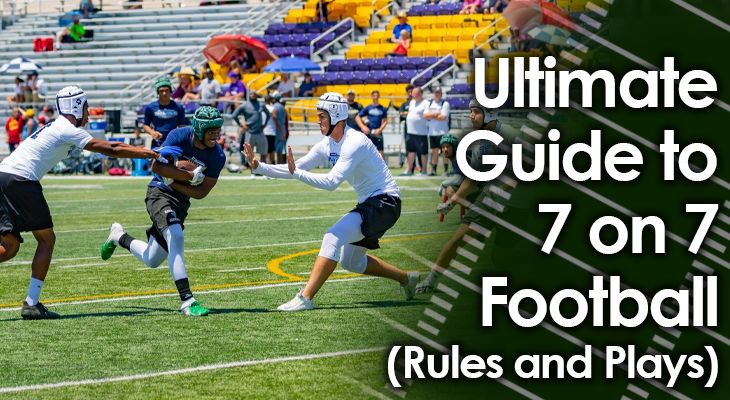Football isn't always played with 11 players on offense and defense.
There are variations of the game that allows players to prioritize having fun and learning specific aspects and areas of the sport.
One of the most popular variations is the 7 on 7 football.
Below, I'll break down exactly what it is, the basic rules, some plays, and much more.
Let's get started.
What is 7 on 7 Football?
7 on 7 Football is a version of football that has 7 players each for offense and defense.
This variation has a strong emphasis on running routes and the passing game, and there isn't any tackling nor are there any pads.
Instead, it's similar to touch football where a player is considered "tackled" if a defender touches him below the neck.
Some versions even have players wear belts with "flags" on them, and a player is tackled when one of the flags or the belt is pulled off by a defender.
7 on 7 is one of the most exciting and fun variations on football.
It's a great way to teach players skills they can then use in a regular 11 on 11 game.
The game is particular popular for youth and high school players, while some universities even have 7 on 7 football leagues for people to have fun.
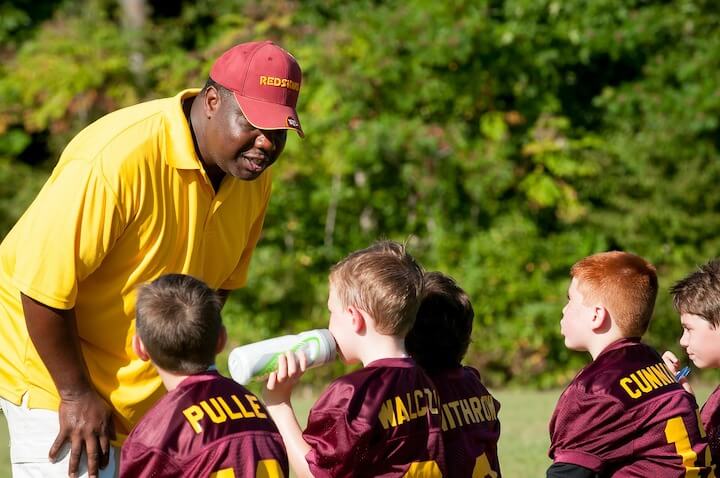
7 on 7 Football Rules
In 7 on 7 football, no contact is allowed.
Players won't be blocking in the traditional sense, nor will there be any tackling. In fact, there are penalties called for any contact similar to that.
Because there is no contact, players will not wear traditional football pads or even helmets. They'll simply wear shorts or pants and a t-shirt, which will signify their team and number as well.
The game will have two halves that last 20 minutes each, with a short halftime between each half of play.
Flag Football:
Many 7 on 7 football leagues will be Flag Football leagues.
In this case, the only piece of "equipment" players will wear is a belt that wraps around their waist outside of their shorts.
There are then 2-3 flags that hang from the belt.
Players are considered tackled when a defender rips one of these flags off the belt, or rips the belt off completely.
Touch Football:
In leagues where players don't wear a belt, tackles are made by simply touching the ball carrier anywhere below the neck.
All it takes is a simple touch. Players don't need push or shove people to the ground or out of bounds.
The way it's constructed allows for plays to be much more free-flowing.
Running in the traditional sense is not allowed as well; all plays must be forward passes of some sort.
The emphasis on a 7 on 7 football game is the passing game.
It allows quarterbacks to work on their passing skills and timing with receivers, and allows receivers to work on their route running and pass catching skills.
7 on 7 Football Rules on Timing
In 7 on 7 football, defenses are not allowed to rush the quarterback.
This may seem like an unfair advantage at first, since quarterbacks would be able to basically pick who they want to throw to.
But, taking a closer look shows us that's simply not the case.
Four (4) Second Rule
The quarterback has four (4) seconds to release the football.
If he doesn't throw a pass within those four (4) seconds, the play will be called dead.
It will be much like a sack, where the next play starts at the point where the quarterback had the football as the time expired.
The offense will also lose a down.
Rules on QB Rushes
The other major rule in regard to how plays work is that the quarterback is not allowed to rush with the football.
In other words, he must throw a pass on every play. He cannot just scramble beyond the line of scrimmage.
Rule on the Snapper
Finally, the person who snaps the football (more on that later) is NOT allowed to go out for a pass.
7 on 7 Football Field
The playing field here will be a lot shorter than a traditional football field.
Instead of being 100 yards long, the 7 on 7 field is usually only around 40 yards long.
The field will be marked with two (2) lines -- a 10-yard line and a 25-yard line.
Starting Possessions:
Unlike traditional football games, there are no kickoffs in 7 on 7 football.
Instead, the offense will start each possession from the 40-yard line.
They'll need to progress 40 yards, then, to score a touchdown.
Number of Downs:
At the beginning of each possession, the offense has three (3) downs.
If they are able to cross over the 25-yard line, they'll convert a first down.
The same is true when they then cross the 10-yard line.
Some formats, however, will award offenses with only one (1) extra down when they cross the 25- and 10-yard lines.
7 on 7 Football Scoring
In many ways, scoring in a 7 on 7 football game is similar to that in traditional football.
There are, however, a few differences.
The goal here is for the offense to cross the opponent's end zone. When the offense successfully does this, it's considered a touchdown and will score six (6) points -- much like traditional football.
Rules on Field Goals:
There isn't a kicking game in 7 on 7 football, though.
Instead of trying to kick an extra point, offenses will have an attempt to score one (1) additional point after a touchdown.
They'll line up at the 10-yard line and have one (1) play to cross the goal line to secure an extra point.
How the Defense Can Score:
Defenses can also get in on the point-scoring action in 7 on 7 football.
In most leagues, defenses score two (2) points each time they intercept a pass, (some leagues reward an interception with three points).
If the defense is able to turn the offense over on downs, they also score two (2) points.
In addition to these scores, their offense will also take over possession to try to score even more.
Because of these, playing good defense is just as vital in 7 on 7 football as playing offense.
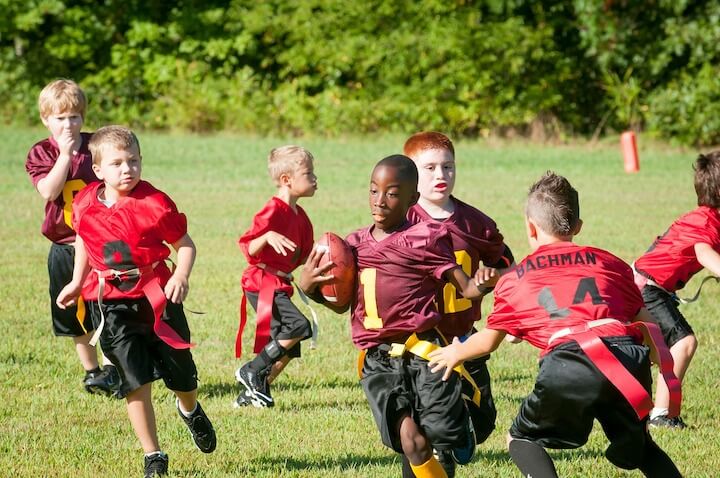
7 on 7 Football Penalties
Despite the absence of blocking, tackling, or rushing the quarterback, there are still penalties in 7 on 7 football.
Most penalties here are pass interference or defensive holding calls, though there are also similar offensive penalties.
In some instances, referees may also call personal fouls or unsportsmanlike conduct.
In all cases, a penalty will result in either the offense losing a down or getting awarded an automatic first down.
All penalties will also be accompanied by either a gain or loss of five (5) yards, based on which team commits the penalty.
7 on 7 Football Positions
As the name of the game suggests, it involves seven (7) players on every play.
With four (4) less players on each team, there is much more room on the field for offenses to run.
Offensive Positions:
The offense will consist of a quarterback, a player who serves as the center (or at least snaps the football) and five receivers.
The center will be ineligible to go out for a pass. That means there will be only 5 eligible receivers on any one play.
There will be no traditional offensive line positions, other than the player who acts like the center.
Defensive Positions:
The defense will have 7 players to position however they want on the field.
Many will play either straight zone defensive coverage, or will run man-to-man coverage with 5 players, with the remaining 2 players acting as safeties in a zone coverage.
7 on 7 Football Plays
Offensive coaches can get really creative with play calling in 7 on 7.
This is really important, actually, as defenses will have an advantage when it comes to each play -- with 7 defenders covering 5 receivers.
As such, coaches need to come up with inventive play calling to confuse defenses and take advantage of the extra spacing on the field.
Here are a few 7 on 7 football plays you can use:
Play #1: Post Corner

This play will have receivers cross each other's faces -- the idea here is to confuse defenders.
The offense will do this by having inside receivers end their routes outside, and the other way around for the outside receivers.
This play will work equally against either man-to-man or zone coverage, or a hybrid version.
- The Left receiver will run a quick hitch route to the inside, while the 3 receiver will run a deep slant to the outside.
- The Right receiver will run a deep post toward the middle with the 4 receiver running a deep slant to the outside.
- The 2 receiver will act as a safety valve, running a flat route to the right side of the field.
Play #2: Post Wheel
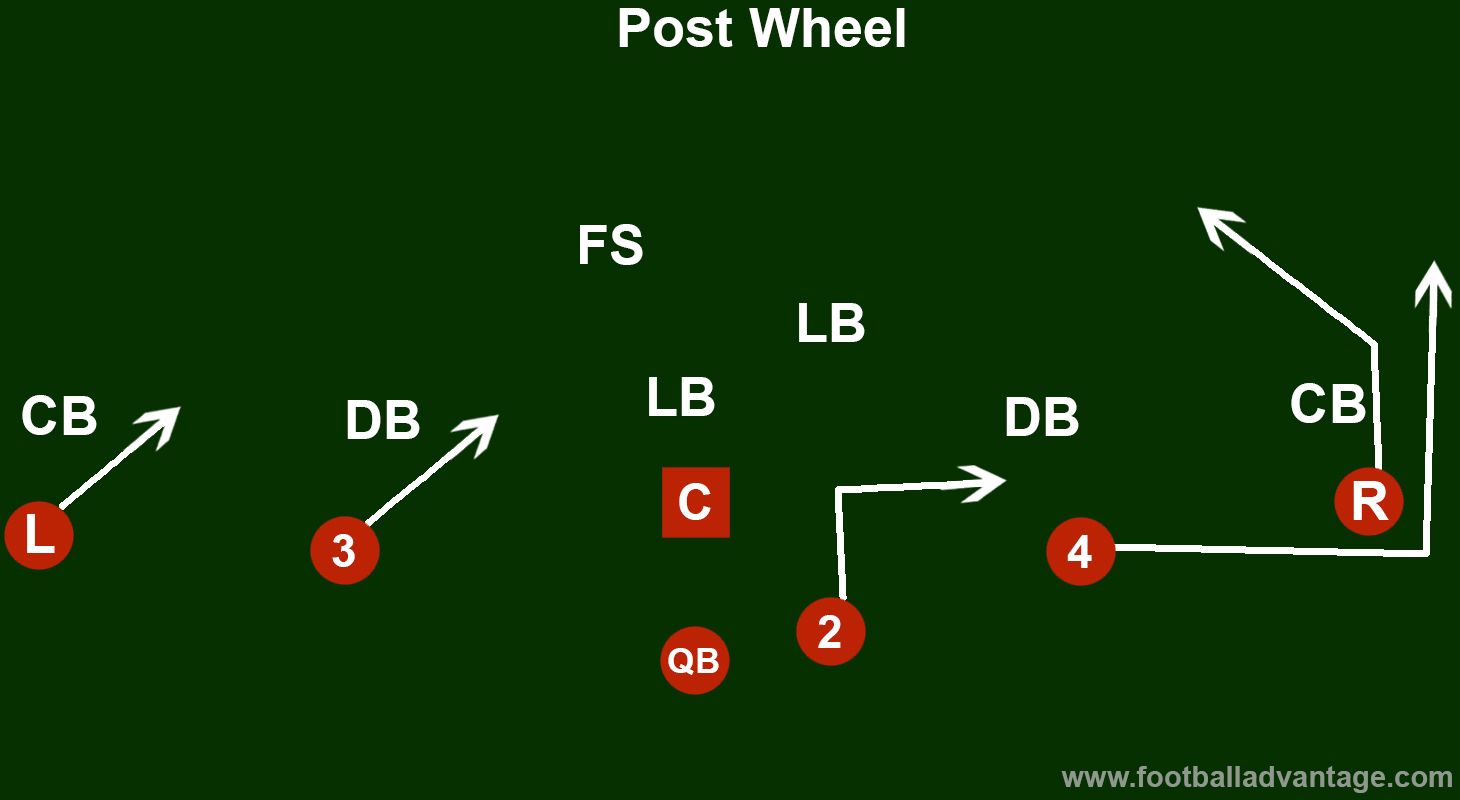
This play is also great against all coverages.
The idea here, again, is to cross the defenders face with multiple receivers, hoping to have one player get open downfield.
The primary targets on this play are the two receivers to the right.
- The Right receiver will run a deep post to the middle of the field, while the 4 loops around behind him and runs a deep wheel route.
- The Left and 3 receivers will run quick slants toward the middle of the field at different depths.
- Meanwhile, the 2 serves as the safety valve again, with a short out route to the right sideline.
Play #3: Rub
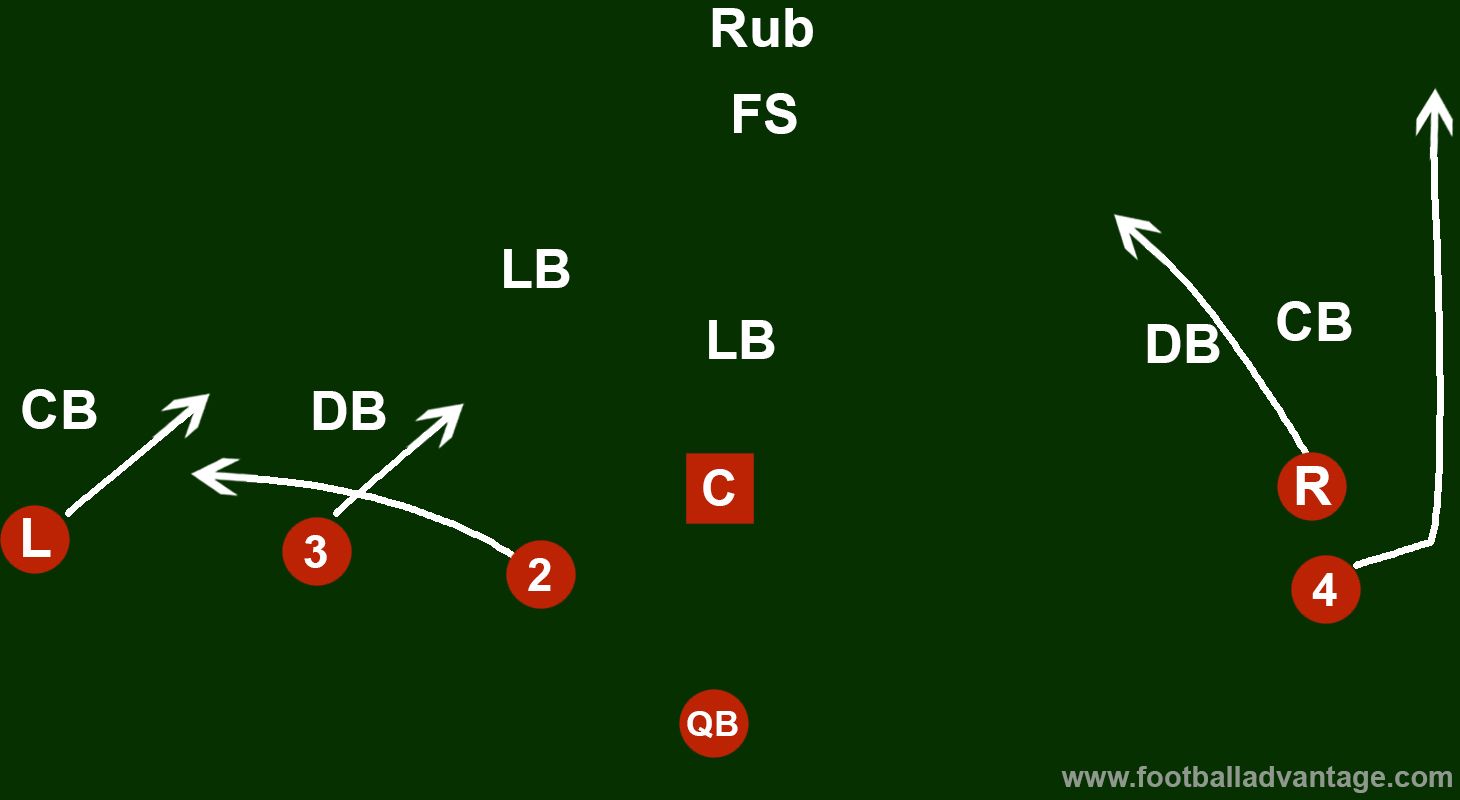
Some of the best plays in 7 on 7 football integrate confusion and what are known as "rubs."
They are basically pick plays designed to have defenders run into each other, thereby allowing receivers to get wide open.
- On this play, the 4 receiver will line up almost directly behind the Right receiver -- this will hide him a bit and confuse both defenders.
- The Right receiver will run a quick deep slant to the middle, while the 4 runs a deep post down the sideline after looping behind the Right.
- The Left and 3 will run quick slants to the middle from their left positions.
- The 2 will run a Flat route to the left sideline, which will cause three (3) defenders to cross each other's paths.
Conclusion
7 on 7 football is a great game that can be a lot of fun while also teaching players some of the most important skills they need for a full game of football.
It's a fast-paced game with a lot of spacing that focuses on passing and catching.
This guide will help you understand how 7 on 7 football is played, as well as some offensive plays you can run to help your team be more successful on the field.

